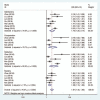Effectiveness of flipped classroom vs traditional lectures in radiology education: A meta-analysis
- PMID: 33019421
- PMCID: PMC7535556
- DOI: 10.1097/MD.0000000000022430
Effectiveness of flipped classroom vs traditional lectures in radiology education: A meta-analysis
Abstract
Background: With the convert of educational concept, flipped classroom has been adopted gradually in radiology courses as a new teaching mode. Considering no evidence has been concluded to illustrate the effectiveness of of flipped classroom over traditional instructor-centered lectures in radiology education, this meta-analysis was conducted to provide empirical evidence for the reform of pedagogical.
Methods: Studies were retrieved from six databases, including Pubmed, Embase, Web of Science, Wanfang Data, CNKI, and VIP, from their inception to 16 February 2020. Literature selection and data extraction were completed by two reviewers independently. The effect size of each index was expressed as the odds ratio (OR) for a categorical variable and standard mean difference (SMD) for a continuous variable, each with corresponding 95% confidence interval (95% CI).
Results: A total of 19 studies with 2114 participants were deemed to be eligible for inclusion. The results of this meta-analysis indicated that: the newly emerged flipped classroom represented significant advantage versus traditional lecture in improving theoretical performance (SMD 1.12, 95% CI 0.61-1.63, P < .001), as well as in cultivating students' practical skills (SMD 2.59, 95% CI 1.69-3.59, P < .001). In the subjective findings of investigation, more positive responses were attained in students who took radiology subjects in flipped classroom, covering course satisfaction (OR 1.70, 95% CI 1.35-2.14, P < .001), improvement of teamwork ability (OR 1.80, 95% CI 1.21-2.67, P = .004), self-directed learning and reflection (OR 1.98, 95% CI 1.31-2.97, P = .001), and subjective cognition on consolidation of knowledge mastery (OR 1.38, 95% CI 1.19-1.60, P < .001).
Conclusion: Flipped classroom displays multiple advantages versus traditional lecture-based teaching mode, which is well worth further promoting and applying in the process of radiology education.
Conflict of interest statement
All the authors declare that there are no relevant conflicts of interest to disclose.
Figures








Comment in
-
A New Normal in Radiology Resident Education: Lessons Learned from the COVID-19 Pandemic.Radiographics. 2021 May-Jun;41(3):E71-E72. doi: 10.1148/rg.2021210030. Radiographics. 2021. PMID: 33939548 Free PMC article. No abstract available.
References
-
- Kelly AM. Radiology education: keeping pace with changing times, new technology, and increased challenges. Acad Radiol 2014;21:827–8. - PubMed
-
- Cheng X, Ka Ho Lee K, Chang EY, et al. The “flipped classroom” approach: stimulating positive learning attitudes and improving mastery of histology among medical students. Anat Sci Educ 2017;10:317–27. - PubMed
-
- Irby DM, Cooke M, O’Brien BC. Calls for reform of medical education by the Carnegie Foundation for the Advancement of Teaching: 1910 and 2010. Acad Med 2010;85:220–7. - PubMed
Publication types
MeSH terms
LinkOut - more resources
Full Text Sources

